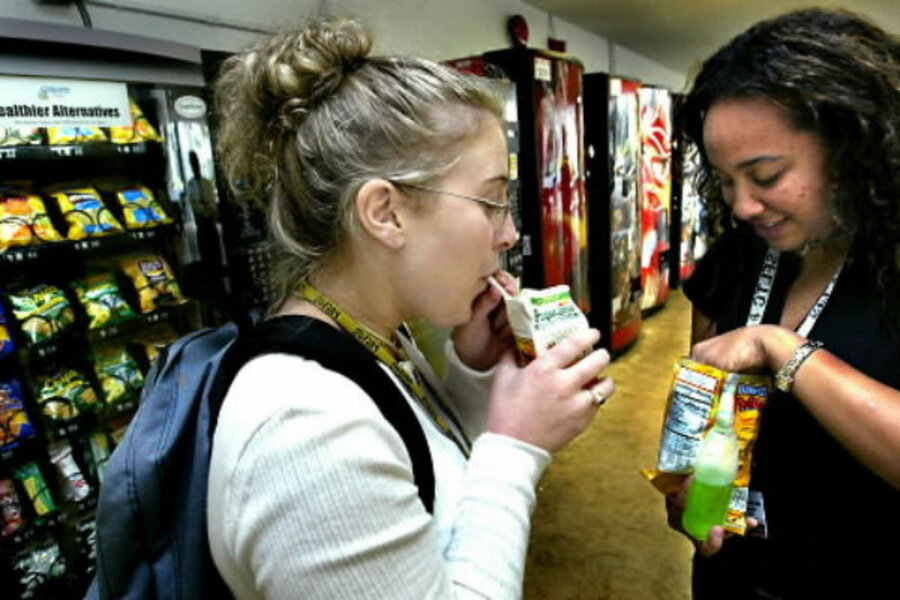Parents support limits on junk food in school vending machines
Loading...
| Washington
Junk food may soon be hard to buy at American public schools as the US government readies new rules requiring healthier foods to be sold beyond the cafeteria – a move most parents support, according to a poll released on Thursday.
With childhood obesity rising, the survey found most people agreed the chips, soda, and candy bars students buy from vending machines or school stores in addition to breakfast and lunch are not nutritious, and they support a national standard for foods sold at schools.
The findings from the advocacy group Kids' Safe and Healthful Foods Project came as the federal government prepares to roll out a nationwide standard that may set up another battle among health experts, schools and the food industry.
The U.S. Department of Agriculture is expected to issue its guidelines by June, according to some experts. These could limit the amount of sugar, salt and fat foods sold at schools could contain.
Agriculture Department Under Secretary Kevin Concannon said an important step in addressing childhood obesity is to help make the "right choice an easy choice" while at school.
"We look forward to working with parents, teachers, school food service professionals, and the food industry to craft workable guidelines so that healthier options are available for our students," he said.
Many states have already enacted their own laws mandating healthier non-cafeteria food options.
Jessica Donze Black, a dietician who leads the Kids' Safe and Healthful Foods Project, said the results show growing support for updating standards that surfaced in 1979.
"What has changed in the last 30 years is that the childhood obesity epidemic has more than tripled," she said. "The school environment has also changed. ... Today, there are a lot of other places throughout the day that compete with kids eating a healthy school meal."
Eighty percent of the 1,010 adults polled said they would support nutritional standards limiting the calories, fat and sodium in such foods. Seventeen percent would oppose it.
Most also agreed there are now few healthy options. Just 5 percent of adults said vending machines offered totally or mostly healthy choices compared with 10 percent for school stores and 21 percent for a la carte lunch lines.
Changes to school foods may be controversial. New standards for more fruits, vegetables and whole grains in traditional school meals announced in January drew scrutiny when lawmakers blocked limits to french fries and counted pizza as a vegetable because it contains tomato sauce.
Efforts to give students more healthy options to help fight childhood obesity have historically faced pressure from food and beverage companies and even from schools themselves, who rely on such food sales for extra cash.
But health experts, pediatricians and other advocates say that is changing as more companies and school districts come on board at a time when more than one-third of USchildren are overweight or obese.
"Most people accept that soda, candy bars and other unhealthy foods just don't deserve a place in school on a regular basis," said Margo Wootan, head of nutrition policy at the Center for Science in the Public Interest.
She said there are still concerns that members of Congress and industry lobbyists could water down the proposal.
The American Academy of Pediatrics' Laura Jana said new rules are imperative now that kids consume more than half of their daily calories in school. More students are getting most of their calories from snacks and drinks, not meals, she said.
"To me, it's a no-brainer.... They can't make that healthy choice when we stick all those temptations under their noses," said Jana, a pediatrician based in Omaha, Nebraska and co-author of "Food Fights: Winning the Nutritional Challenges of Parenthood Armed with Insight, Humor and a Bottle of Ketchup."
Food and beverage makers have expanded their portfolios to include juice, granola bars and other healthier products. Vending machine companies focused on nutritious offerings have also sprung up.
US drink companies have already taken voluntary steps to keep sodas out of some schools and their trade group says this has cut calories consumed from beverages in schools by 88 percent.
Christopher Gindlesperger, spokesman for the American Beverage Association, said its voluntary guidelines are a good model for the government to follow.
"It's a standard that's already in place that is working. It strikes a balance," he said.
ABA's guidelines eliminate soda in elementary and middle schools but allow diet sodas and low-calorie sports drinks in high school.
Companies such as The Coca-Cola Co, PepsiCo Inc, and Nestle SA either had no immediate comment or referred questions to industry trade groups.
Mars Inc, maker of the iconic M&M's chocolate candies, said it has already agreed to withdraw branded vending machines from schools and does not offer traditional candy in those settings. Mars said it has instead developed other, lower-calorie products.
As for schools, most now realize vending machines can help teach students about healthy habits and boost learning even though money does loom large, said Whitney Meagher, project director for the National Association of State Boards of Education.
"If you have a choice between a cookie and an apple and the cookie is going to sell better, it's hard not to make that decision as a business decision," she said.
The Kids' Safe and Healthful Foods Project is a joint venture by the nonprofit policy group The Pew Charitable Trusts and the Robert Wood Johnson Foundation, a private organization that aims to improve Americans' health.
Its poll surveyed 1,010 registered voters by telephone in mid-January and has a margin-of-error of plus-or-minus 3.1 percentage points.





